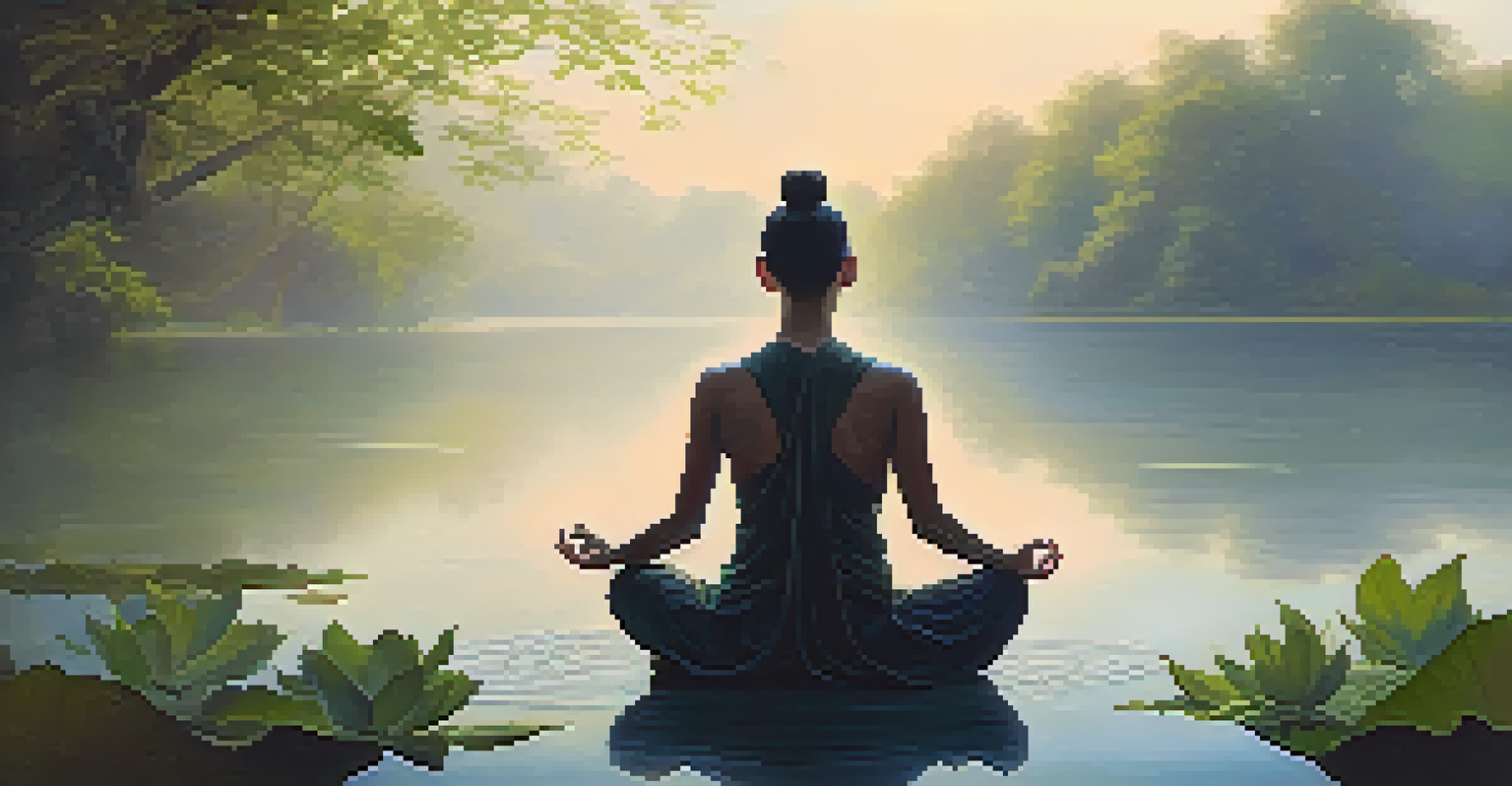Top Yoga Poses to Foster Self-Love and Inner Kindness

Understanding the Importance of Self-Love in Yoga
Self-love is a foundational element in yoga, allowing us to connect with our true selves. It encourages acceptance and compassion, both towards ourselves and others. By cultivating self-love, we create a nurturing space for personal growth and emotional healing.
You yourself, as much as anybody in the entire universe, deserve your love and affection.
Yoga serves as a gentle reminder that our bodies are not just vessels but integral parts of our identity. When we practice self-love on the mat, we learn to embrace our imperfections and celebrate our strengths. This mindset can transform not just our yoga practice, but our overall outlook on life.
Incorporating self-love into our yoga routine leads to deeper mindfulness and a more enriching practice. It’s about being kind to ourselves, allowing us to flow through our poses with grace. Let’s explore specific poses that can enhance this journey towards self-acceptance.
Child's Pose: Finding Comfort and Safety
Child's Pose, or Balasana, is a restorative position that fosters a sense of safety and comfort. It invites us to turn inward, offering a moment to pause and reconnect with our breath. As we fold forward, we allow ourselves to feel supported by the earth beneath us.

This pose encourages surrender, reminding us that it’s okay to take a break and prioritize self-care. It can be particularly soothing during moments of anxiety or self-doubt. By embracing this nurturing pose, we practice kindness towards ourselves, acknowledging our need for rest.
Integrate Self-Love in Daily Life
Incorporating self-love into our routines nurtures our overall well-being and inspires others.
In Child's Pose, we cultivate a loving dialogue with our bodies. As we breathe deeply, we can affirm our worthiness and strength. This pose sets the stage for deeper self-love as we learn to value our own needs.
Cobra Pose: Opening the Heart with Confidence
Cobra Pose, or Bhujangasana, is all about opening the heart and embracing vulnerability. As we lift our chest and shoulders off the ground, we symbolize our willingness to be seen and loved. This action can feel empowering, reminding us of the strength that lies in openness.
Self-love is not selfish; you cannot truly love another until you know how to love yourself.
This pose not only strengthens the spine but also encourages us to release tension held in the chest. When we open our hearts, we create space for self-acceptance and kindness. It’s a gentle reminder that vulnerability is a strength, not a weakness.
In practicing Cobra Pose, we affirm our self-worth and the beauty of being authentic. Each lift is a celebration of who we are, flaws and all. Through this pose, we invite self-love into our hearts, fostering inner kindness.
Warrior II: Embracing Strength and Courage
Warrior II, or Virabhadrasana II, embodies strength and courage, essential components of self-love. As we extend our arms and ground our feet, we assert our presence in the world. This pose encourages us to stand tall, both physically and emotionally, embracing our unique journey.
Practicing Warrior II allows us to confront our fears and acknowledge our worth. It’s about finding balance between assertiveness and compassion. In this pose, we learn that loving ourselves means standing firmly in our truth.
Self-Love Enhances Yoga Practice
Cultivating self-love through yoga fosters personal growth and emotional healing.
As we hold Warrior II, we can visualize our self-love radiating outward. This pose not only strengthens our body but also fortifies our spirit. Embracing our inner warrior empowers us to foster kindness towards ourselves and others.
Bridge Pose: Creating Space for Love
Bridge Pose, or Setu Bandhasana, encourages us to open our hearts and create space for love. As we lift our hips towards the sky, we are literally elevating our energy and inviting positivity into our lives. This pose embodies the essence of self-acceptance and connection.
By engaging the back muscles and opening the chest, we release pent-up emotions and foster an environment of kindness. It’s a beautiful reminder that self-love often requires us to let go of what no longer serves us. Each lift in Bridge Pose symbolizes our commitment to nurturing our well-being.
In this pose, we can visualize our hearts growing larger, filled with love for ourselves. The bridge becomes a symbol of our journey towards self-kindness, reminding us to celebrate our unique path. Through this practice, we learn to embrace our wholeness.
Cat-Cow Stretch: Gentle Flow for Self-Compassion
The Cat-Cow Stretch is a gentle flow that encourages self-compassion and mindfulness. This sequence allows us to connect with our breath while moving through different states of being. It serves as a reminder that self-love involves both nurturing and releasing.
As we arch and round our backs, we embody the ebb and flow of life. The Cat position invites us to acknowledge our shadows, while the Cow position encourages us to embrace our light. This duality reflects the importance of accepting all parts of ourselves.
Embrace Vulnerability with Poses
Poses like Cobra and Warrior II encourage embracing vulnerability and self-acceptance.
Through this dynamic movement, we learn to treat ourselves with kindness. The Cat-Cow Stretch teaches us that it’s okay to feel a range of emotions and that self-love means honoring them all. Each transition helps us cultivate a compassionate relationship with ourselves.
Lotus Pose: Cultivating Inner Peace and Acceptance
Lotus Pose, or Padmasana, is a powerful position for cultivating inner peace and acceptance. Sitting comfortably, we ground ourselves and connect with our breath, fostering a sense of stillness. This pose encourages us to turn inward, promoting self-reflection and love.
In Lotus Pose, we create a sanctuary within ourselves where self-judgment has no place. This quiet space allows us to listen to our inner voice, nurturing a loving dialogue. As we sit in stillness, we can embrace our true selves without the distractions of the outside world.

By practicing Lotus Pose regularly, we reinforce our commitment to self-love. It’s a space where we can foster kindness and acceptance, reminding ourselves that we are enough just as we are. Each moment spent in this pose deepens our connection to self-compassion.
Final Thoughts: Integrating Self-Love into Daily Life
Integrating self-love into our daily lives requires mindfulness and intentionality. As we practice these yoga poses, we can carry the lessons of self-acceptance and kindness off the mat. It's about creating a lifestyle that honors our worth and nurtures our well-being.
Self-love is not a destination but a continuous journey. By weaving these yoga practices into our routines, we can cultivate a deeper appreciation for ourselves. This transformative journey impacts not only our physical health but also our emotional and spiritual well-being.
Self-Love is Key in Yoga Practice
Cultivating self-love enhances our yoga experience and promotes personal growth and emotional healing.
In embracing self-love through yoga, we inspire others to do the same. Let’s commit to practicing kindness towards ourselves and radiate that love into the world. By fostering a culture of self-acceptance, we can build a community rooted in compassion and understanding.